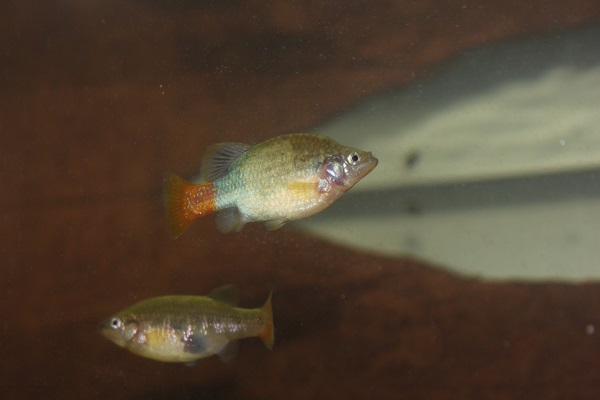Photo is of a pair of Xenotoca eiseni, Rio Tamazula (the Redtail Goodeid).
This is a nice little fish we’ve had since 2004 when we bought them at an American Livebearers Association auction. They were originally collected from the Rio Tamazula in Mexico by Rusty Wessel prior to that time.
This fish belongs in the family Goodeidae, which has 18 genera and 45 species (some of which are now probably extinct). Goodeids hail from Mexico’s central plateau west of Mexico City. Although considered relatives of the pupfishes, unlike the pupfishes, they are viviparous (livebearing). Goodeids differ from common livebearers such as guppies, swordtails, and platies, since the male goodeids don’t possess a, a penis–like gonopodium. Male goodeids instead have a modified anal fin with a notch or split in the middle of the fin. Reminiscent of killifish mating, goodeid males sidle next to females and press against them to transfer sperm. In another difference with common livebearers, female goodeids have an internal placenta-like structure, the trophotaenia, which provides nourishment to the embryos. Also, goodeid females must mate after delivery of fry in order to produce more fry since they don’t store sperm like the more common livebearers.
I first kept this species (although not the Rio Tamazula population) in the early 1970s while in college. I don’t remember how I acquired them, but do remember peddling them to shops in Austin. One of the shops named them “Tacofish” and sold lots of them. The fish I had then were larger than the Rio Tamazula population, growing to almost three inches. The Rio Tamazula fish don’t grow larger than two inches. The females were drabber than the Rio Tamazula females, which show some orange in the caudal. At some point I lost the original fish, so I was pleased to find the species in the auction.
They are very prolific and we usually have a few hundred on hand and plan to keep them just in case they go extinct in the wild as have some of their relatives.
Good fishkeeping!


Kyle says
The Tamazula population has been reclassified. They are now Xenotoca Lyonsi.
charles says
Kyle,
Yes, I’m aware of that. But, long ago we decided to reply upon one authority and only one. That authority is the Integrated Taxonomic Information System (see https://itis.gov/). Why? Well first one could go crazy attempting to keep up with all the publications and various sources, many of which disagree with each other. Second, ITIS is the authority our government relies on when applying the Lacy Act and the Endangered Species Act. ITIS is conservative and awaits general consensus before accepting new names and reclassification. As of a few minutes ago, ITIS has not accepted the splitting of Xenotoca eiseni into X. lyonsi and other species. I respect Dr. Lyons work and anticipate that ITIS will someday recognize those splits. In the meantime, I’ll continue to conform with ITIS, but as you noticed, I’ll provide location information so that others can use the new name if they so wish.
Charles
Kyle says
Oh, I guess that makes sense if your following Itis. Guess that helps stay in line with your government’s laws and regulations.